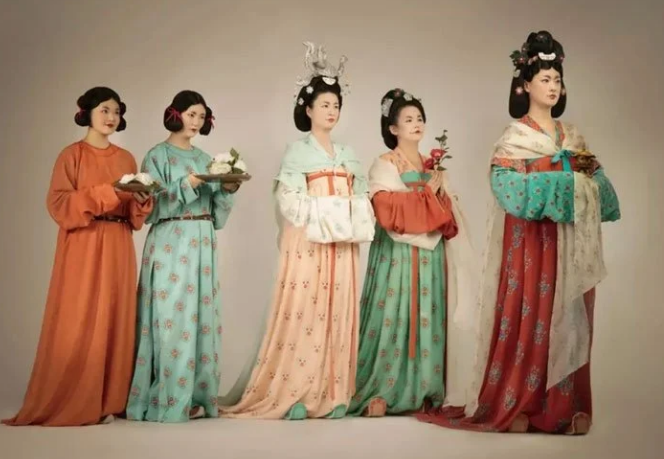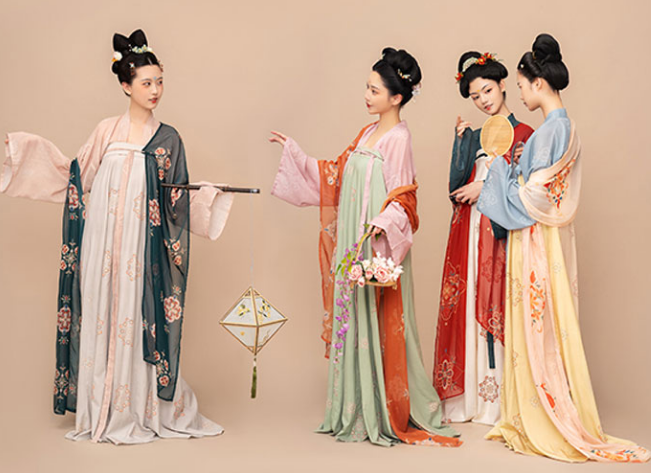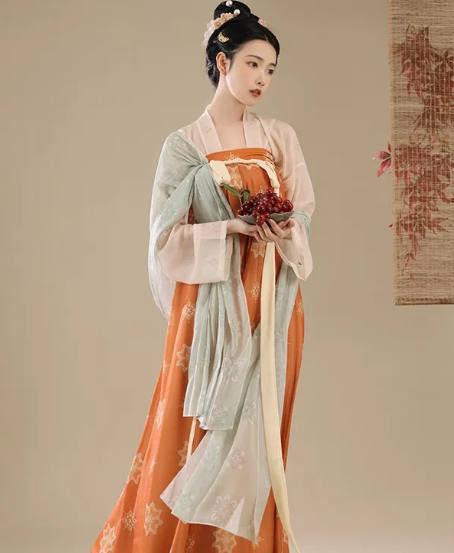Historical Overview of Tang Dynasty Attire
The Tang Dynasty, spanning from 618 to 907 AD, is often considered a high point in Chinese civilization, and this extends to its fashion. The era saw an unprecedented flourishing of culture and arts, which was vividly reflected in the clothing of the time.
The Evolution of Tang Dynasty Fashion
The progression of Tang Dynasty fashion mirrored the dynasty’s fortunes. Early Tang garments were relatively simple, echoing the styles of previous dynasties. However, as the empire expanded and became more prosperous, clothing styles evolved to become more elaborate and colorful. The cross-cultural exchanges along the Silk Road introduced new fabrics and designs, leading to wider sleeves, higher waistlines, and the introduction of garments such as the “Beizi” — a loose-fitting jacket. Materials like silk were in high demand, as they signified social status and wealth.

Influences on Clothing Design in the Tang Dynasty
Tang clothing design drew from a broad palette of cultural influences. Contact with Central Asia, Persia, and even the Byzantine Empire brought new ideas and materials to Tang tailors and fashion. Buddhism and its associated garments also exerted a significant influence, contributing to the popularity of flowing robes and shawls. During this time, a fusion of Chinese and foreign elements became the hallmark of Tang attire.
For example, the use of silk was not only a matter of aesthetics but also a reflection of China’s vibrant trade with distant regions. Moreover, the empire’s openness led to the incorporation of various motifs and patterns from other cultures into the fabric designs, showcasing a unique cosmopolitan style of dress. The Tang Dynasty’s capital, Chang’an, was a cosmopolitan city, which is evident in the clothing artifacts excavated from the period, displaying an array of patterns, colors, and cuts from diverse origins.
Classification of Tang Dynasty Costumes
The Tang Dynasty’s sartorial landscape featured a distinct classification system that underscored the social hierarchy and reflected the cultural vibrancy of the time. Costumes ranged from the sumptuous attire of the imperial court to the more practical garments of the common people.
Court and Ceremonial Attire
Royal clothing embodied the zenith of Tang fashion, often made from the finest silk and decorated with intricate embroidery. Court attire was not just clothing but a canvas for showcasing wealth and artistry. The emperor and high-ranking officials wore robes with dragon motifs, with the number of claws on the dragon indicating rank. Officials’ robes differed in color and ornamentation according to their position and the occasion, with specific hues reserved for particular events.
For instance, during grand ceremonies, robes could be adorned with gold threads and jade, adding to the garment’s value and the splendor of the event. Fabric quality, dyeing techniques, and embroidery sophistication often indicated the wearer’s social status. These garments were costly, with historical records indicating that a single court robe could be worth an entire year’s income for a commoner.
Everyday Wear for Commoners
In contrast to the opulent court garb, common Tang citizens wore more functional attire. Nonetheless, it still reflected the era’s fashion sense with its wide sleeves and loose cuts. Materials were less luxurious, often made from hemp or cotton, which were more affordable and durable for daily activities. The color of common clothing was typically subdued, as vibrant dyes were expensive and reserved for the upper class.
Men’s everyday wear usually included a top garment called a “Yi” and a lower garment known as “Ku,” while women frequently wore a “Ruqun,” a combination of a blouse and a wrap-around skirt. These garments allowed for ease of movement and adaptability to different work scenarios. Despite their simplicity, commoners’ attire also changed with the fashions of the day, albeit in a more subdued manner, as they adopted simplified versions of popular styles.
Through these distinct costume classifications, the Tang Dynasty showcased its social structure, economic stratification, and the pervasive influence of fashion across all levels of society.
Traditional Garments of the Tang Dynasty
The Tang Dynasty, a period known for its openness and cultural diversity, left a remarkable legacy in traditional Chinese garments, with the “Hanfu” being the most emblematic.
The Proliferation of the Hanfu
“Hanfu” refers to the traditional clothing of the Han Chinese people, which became particularly prominent during the Tang Dynasty. These garments showcased a preference for wide sleeves, flowing skirts, and a layered look. They often featured cross-collared robes, known as “jiaoling youren,” or “ruyi” which means the collar forms a right angle at the neckline. The cross-collared robe served as a canvas for expressing personal wealth, as the silk fabric, along with decorations such as embroidered borders, increased its aesthetic and monetary value. Even commoners wore Hanfu, though their versions used more affordable materials like cotton.
The Hanfu saw various adaptations during the Tang era, where clothing not only fulfilled basic needs but also reflected social norms and aesthetics. This garment had no pockets, so people carried items in sleeve pouches or belts, indicating that practicality sometimes bowed to style.
Variations of the Shenyi
The “Shenyi” is another traditional garment that underwent several adaptations in the Tang Dynasty. It is a one-piece robe or a combination of a tunic and skirt sewn together. Shenyi designs varied depending on the wearer’s social standing and the occasion.
For example, the “Zhiju Shenyi,” characterized by straight lines and a squared sleeve design, was popular for its simplicity and comfort. The quality of the Shenyi, like other Tang garments, depended on the wearer’s financial capability. While silk Shenyi represented the pinnacle of elegance, those made of hemp signified modesty. Despite the material differences, all variations maintained a harmonious balance between functionality and aesthetics, reflecting the Tang people’s appreciation for both form and utility.
In all these garments, artisans would measure and cut fabrics with precision, ensuring that each piece fitted the wearer’s body size while allowing enough movement. These clothing pieces were more than just utilitarian objects; they were integral to the cultural tapestry of the Tang Dynasty.
Women’s Fashion During the Tang Dynasty
Women’s fashion in the Tang Dynasty celebrated opulence and was a blend of domestic traditions and foreign influences. Clothing was not only a reflection of status but also a statement of fashion.

The Exquisite Hufu: Foreign-Inspired Dresses
The “Hufu,” which translates to “barbarian clothing,” was an exotic style of dress inspired by the fashions of various nomadic tribes that interacted with the Tang Dynasty. Women often wore these loose, comfortable robes that were once considered unconventional. The Tang’s open exchange policies encouraged the adoption and adaptation of these foreign styles, which soon became a vogue among the elite. The Hufu’s integration signified cultural openness, with Central Asian influences evident in the form of side-fastenings and knee-length tunics.
Tang women paired Hufu with wide belts to cinch at the waist, highlighting their figures. The cost of a Hufu could vary greatly, from affordable plain linen to luxurious silk embroidered with gold thread, costing upwards of several hundred strings of cash, a small fortune at the time.
Accessories and Hairdressing in Tang Women’s Fashion
Accessories played an essential role in Tang women’s ensembles. They favored ornate hairpins made of gold, silver, jade, or even kingfisher feathers. These hairpins were not mere adornments; they signified a woman’s social standing and personal wealth. Hairstyles were equally elaborate, with high buns and intricate arrangements that could denote marital status or even political alignment.
Women also adorned themselves with jewelry like necklaces, bracelets, and rings. Craftsmen meticulously crafted these pieces, often requiring days or weeks to complete a single item. A luxurious hairpin, for example, could cost as much as 10 taels of silver, which was a substantial sum for an average family.
Fashion extended to footwear as well, with women wearing shoes made from silk brocade and sometimes even fur during colder months. The aesthetic appeal of Tang women’s fashion, marked by the harmonious combination of clothing, accessories, and hairdressing, showcased the era’s advanced textile industry and artistic refinement.
Men’s Dress and Military Attire
In the Tang Dynasty, men’s clothing was as much a status symbol as it was for women, with the military attire displaying functionality and might.
Scholar-Official Robes and Their Significance
Scholar-officials in the Tang Dynasty distinguished themselves with robes that had specific sartorial markers to denote their rank and status. These officials wore “Mang Pao,” a type of robe with square sleeves and a round neck, often adorned with patches called “rank badges” that depicted birds or mythical animals. The materials used were indicative of their position; higher officials had robes made of fine silk, which could cost several hundred strings of cash.
Robes for scholars and officials served as visual cues of their scholarly achievements and bureaucratic positions. Wearing such attire was a privilege earned through passing the imperial examinations, which had a minuscule success rate, often less than 1%.

Armor and Uniforms of Tang Soldiers
The soldiers of the Tang Dynasty wore armor that was both protective and indicative of their role within the military. The armor combined practicality with impressive aesthetics, often made of leather or metal plates, which could deflect arrows and resist sword slashes. Infantrymen typically wore lighter armor to facilitate movement, while cavalry units had more robust and heavier armor to offer greater protection.
The cost of a full set of armor was substantial, amounting to the equivalent of a small farm’s yearly output. A cavalryman’s armor, for example, could cost over 1,000 strings of cash. Each piece of the armor was tailored to fit the soldier, ensuring maximum protection and agility. Helmets and boots were reinforced, and the belts were sturdy to support weapons.
Military uniforms also conveyed rank through color and ornamentation. Generals wore distinctive robes, often with elaborate designs, to stand out on the battlefield. These robes not only served as a protective layer but also as a morale booster for the troops, who would rally behind the vivid insignia of their commanders.
The Legacy and Revival of Tang Costumes
The Tang Dynasty’s costumes have not only influenced the historical narrative of Chinese fashion but have also sparked a contemporary revival in the form of “Hanfu” movements.
Tang Dynasty Influence on Modern Fashion
Designers today draw inspiration from the rich tapestry of Tang attire, integrating elements like wide sleeves and flowing robes into modern fashion. Such garments often appear in high-profile runway shows and are celebrated for their elegant silhouettes and elaborate patterns. Modern adaptations of Tang costumes can vary greatly in price, with some designer pieces fetching thousands of dollars, depending on the intricacy of the design and the quality of materials used.
The resurgence of traditional Tang-inspired clothing reflects a broader interest in cultural heritage and identity among younger generations. Social media platforms have played a critical role in this revival, with communities dedicated to sharing images and information about Tang fashions.
Preservation and Reconstruction of Traditional Tang Attire
Efforts to preserve and reconstruct traditional Tang costumes involve meticulous research, often delving into ancient texts and artworks to understand the original specifications and designs. The reconstruction process is a blend of scholarship and craftsmanship, with experts striving to use materials and techniques true to the Tang era. These reconstructed garments are crucial for educational purposes and cultural festivals, allowing people to experience the richness of Tang culture firsthand.
The cost of reconstructing traditional Tang costumes can be substantial, as authentic materials like silk brocade and natural dyes are expensive. A single reconstructed costume for a museum display may cost several thousand dollars, excluding the hours of labor by skilled artisans. However, the value of these garments transcends their monetary cost, as they serve as a bridge connecting the past to the present, allowing a glimpse into the aesthetic and cultural norms of one of China’s golden eras.